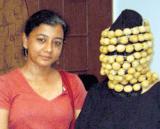It rained ideas
The ample series of performances by mostly young local artists at Gallery Rasa on September 27 was another contribution from the well-guided enthusiasm and organisational skills of Smitha Cariappa, who has by now virtually institutionalised her efforts under the title of Live Art Lab being a part of BAR1 activities.
One has to congratulate her not just for practising performance since a time when it had only a slight presence in the country and none in the city, but also for encouraging and involving others, especially art students and young artists. At the moment as things are still beginning to take shape, one is bound to appreciate the fact that several people from within the circle, even many who otherwise engage with different media, are fascinated by the manifold potential of performance, while understanding that a degree of chaos, chance and mistakes belongs to the process, although some words of caution may not be out of place.
Although it did not start the event, Cariappa’s piece veritably introduced it in a gracefully simple and poetic manner, encapsulating her role as a creative but neutral and open-ended stimulant towards new ideas of the participants by using the metaphor of archaic rain-induction magic.
One could see the work of Deepak D L as complementary here with its humorous-serious combination of objectivity and randomness that admitted uncertainty whether performance has to mean something. Allowed so the freedom of individual interpretation, the present writer would like to stress the spectator’s primary need for sensation pointing to associations that becomes enhanced by its being incorporated in the live person of the performing artist. For this to happen during an actual contact of the viewer with the performer, the artist’s looks, gestures and behaviour along with the significant accessories and background have to be quickly recognisable at least in general terms, even if complexities of thought are to be considered carefully later. Without that, arbitrary or arcane symbolism risks turning into intellectual puzzles which tends to distract the audience from the mood as well as to confuse the reading of intended content. The varied sequence of performances had examples of both extreme options and in-between stages.
Perhaps the best one, anchoring in sheer sensation but thoughtful, which also formed another overture for the day, was by Aishwarya Sultana. Ingeniously using the large window outside and inside the hall, she cleaned it, wrote on it with water, erased it and tried looking within, indeed letting one viscerally yet subtly intuit the perceptual aspirations behind art-making and witnessing art.
Suresh Kumar G was equally inventive and topical in his use of the window in the interior and the noisy traffic on the road considering two, not entirely opposite sides of the observer and observation along with the two sides of screening oneself off and being exposed. The pieces by Dimple Shah, Mangala and Justine Williams dealing with rather diverse issues of anonymity versus fame, identity and truthfulness oscillated between authenticity of concerns or engagement with spectacular visuals and a confusing metaphorical language which troubled in particular with Shah’s effort being partly excellent.
The most layered in his not quite recognisable symbolism was Prakash L. At the other spectrum of message – simplicity and visual or aural primacy – were Anjana Kothamachu, Vasudev and Raghu Wodayar. They knotted fabric of dream by the first kind of illustrating a poem, the second somewhat formalistically tracing link lines between the body, dance and art, the last in a plain yet evocative way, conjuring a noisy crowd of self-centred mobile phone addicts.
Yearly gamut
The ninth annual show with 45 Indian artists 2012 at Galerie Sara Arakkal (August 25 to September 15) was a display very similar to what comes up there as a sort of yearly review of the institution’s steady repertoire while accommodating some slight changes.
The general profile continued with its emphasis on the traditional genres of painting and a few sculptures and a sporadic presence of once innovative photography-based and other complex media. It continued the preference for pleasant and often predictable styles as well, even though on the whole the level improved, thanks to a lesser number of very old-fashioned and amateurish idioms whereas comparatively progressive and ambitious artists could be noticed more often. With some all-India seniors from the always admirable K G Subramanian to Lalitha Lajmi and Achuthan Kudallur, to Yusuf Arakkal and S G Vasudev locally, the gamut included several middling styles together with some interesting contributions by mid-career artists (Rm Palaniappan, C F John) and especially younger ones from around here, like Ravikumar Kashi, Udaya Vir Singh, Manush C J, Gopinath S and Alok Johri.
source: http://www.DeccanHerald.com / Home> Supplements> Art Review / by Marta Jakimowicz / DHNS, October 07th, 2012
